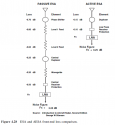It sounds like marketing talk. Every company talks like they are a pioneer of something. Like Apple talking about their innovation while copying Samsung.
300 million investment doesn't sound something that China, Russia or even Spain can't afford into the technology.
They have to do it because no one else in the US does. To have a custom fab just for your own purpose of making it "China-free" is very expensive, since you cannot amortize the fab doing civilian and commercial applications. This has some precedents for example, in a case involving a certain chemical that is used to make the propellant for the Hellfire missile. Turns out no one in the world makes it but this obscure plant in China, and they have been importing this chemical for a while already, only to discover under audit the chemical was coming from China. So the Army had to finance to make a plant just for the exclusive purpose of making this chemical in the US.
Going back to Gallium, China is the leading producer of both crude and highly refined Gallium. Russia is also high in the list.
While the US and other Western nations wants to corner GaAs and GaN for military applications, China wants to do it for commercial and civilian reasons, and by doing so, made the product cheap.
Commercial applications range from telecom base stations, to smartphones, TVs, and not the least, LED diodes. The Chinese government was pushing for LED lighting production to replace all forms of other lighting in a vast countrywide program to save energy. That's why you see GaN even on those LED flashlights you can buy.
The Chinese luxurious exuberance of throwing AESA solutions into just about everything --- 5G will use it (back to Huawei and ZTE again) --- has something to do that for China, doing it this way is not expensive for them, they are brimming with the sources for it, and yet it would be extravagantly expensive for the US. Cost was the reason why the SPY-4 AESA S-band search radar was removed from the Zumwalt class.
So, any advantage gained from GaN disappeared in the past years, or will disappear before 20s.
After all that left is the size / cooling capacity differences, and the experience with the software .
In the latest the Russians had a clear advantage, in the later the USA has a clear disadvantage compared to Ru/Cn
I believe Raytheon's first GaN based radar is the MPQ-65 which is the new radar for the Patriot system. Japan however beat them to the punch in naval radars, with the first GaN radar on the Asahi class destroyer, which is a new variant of the Akizuki class. This is a virtual tie with Germany, whose Cassidian is making the TRS-4D which is the radar for those expensive F125 frigates. However it is also said that the radars for the Type 055 are also using GaN which will put the ship in the bleeding edge of technology but China keeps all information to itself to keep you guessing. Raytheon wants to put GaN radars on the Flight III Burke as the SPY-6, currently in testing, and a smaller version of it is the EADS, meant for the FFG(X). Thales Nederland is offering APAR Block II which is GaN based.
I am interested to know if the new AESA radar proposed for the JF-17 might be GaN based. As these substrates run cooler than GaAs, it would make it possible for the radar to be air cooled and use less power. Conversely, if you allow it to be liquid cooled and is willing to throw much more power at it, it will have greater performance.











